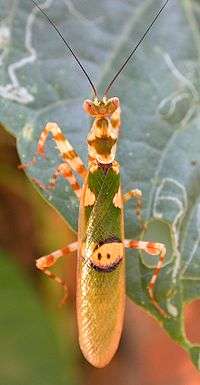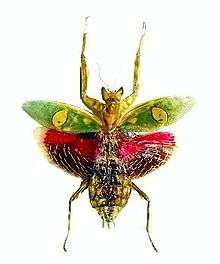Creobroter
| Flower Mantis | |
|---|---|
 | |
| Creobroter gemmatus | |
| Scientific classification | |
| Kingdom: | Animalia |
| Phylum: | Arthropoda |
| Class: | Insecta |
| Order: | Mantodea |
| Family: | Hymenopodidae |
| Subfamily: | Hymenopodinae |
| Tribe: | Hymenopodini |
| Genus: | Creobroter Westwood, 1889 |
| Species | |
|
see text | |
Creobroter or flower mantises is a genus of mantis concentrated in Western Asia. The name comes from the Greek "kreas" (combining form "kreo-", meaning "flesh"), and "broter" (eating); therefore, "flesh-eating", an apt name for a predatory insect. Both sexes have long wings and are capable fliers. Full-grown males are about 3 to 4 cm in length, females about 4 to 5 cm.[1][2]
Camouflage and mimicry

As the common name indicates, Creobroter are known for having varicolored (yellow, white, red, brown, etc.) markings which serve as camouflage by hiding the creatures' actual shape and making them look somewhat like flowers when hiding amidst green foliage.[2][3]
The resemblance to flowers may be greater in sub-adult Creobroter than those that are fully grown. This flower-mimicry is only partial, but is attractive enough to make Creobroter favored as pets, especially as Creobroter species are more common and less delicate than the more flower-like Hymenopus.[1][2][4]
In some Creobroter (such as C. gemmatus) these markings also serve as eyespots when the mantis spreads its wings in a deimatic display.[5]
Rather than resembling foliage or flowers, some species of Creobroter resemble ants during their early nymph stages. Ant mimicry is a useful defense against predation for the young Creobroter, as most ants are relatively unpalatable and aggressive making insect predators that rely on vision to identify their prey, such as birds and wasps, avoid them.[2]
Around their third ecdysis, Creobroter trade their ant-mimicking dark, shiny appearance for the green and light-colored markings that make their outline so difficult to discern amidst vegetation.[2]
Species
There are just over twenty species of Creobroter described including the following:[2][6]
- C. elongatus (Beier, 1929)
- C. fasciatus (Werner, 1927)
- C. gemmatus (Stoll, 1813)
- C. medanus (Giglio-Tos, 1915)
- C. meleagris
- C. nebulosus (Zheng, 1988)
- C. pictipennis (Wood-Mason, 1878)
- C. urbanus (Fabricus, 1775)
See also
Bibliography
- For a technical discussion of an aspect of this genus' anatomy refer to The cervical sclerites of Mantodea discussed in the context of dictypoteran phylogency by Frank Wieland, Entomologische Abhandlungen 63, Museum fur Dresden, 2006
References
- 1 2 "Creobroter Elongata, Gemmatus, Meleagris, Pictipennis". Mantisinc. Retrieved 2007-01-19.
- 1 2 3 4 5 6 "Creobroter". Mantis Online. Retrieved 2007-01-19.
- ↑ "Creobroter gemmatus". Them Bugs. Retrieved 2007-01-19.
- ↑ "Indian Flower Mantis". Central Pets.com. Retrieved 2007-01-19.
- ↑ This Thembugs.com: image.
- ↑ There is no consistency for the use of English language common names for these species. For example, at least two Creobroter species found in India have been called "Indian flower mantis." Conversely, a Creobroter collected in Thailand might be displayed in a collection as a "Thai flower mantis" while the same species collected elsewhere might be called a "Malaysian flower mantis".